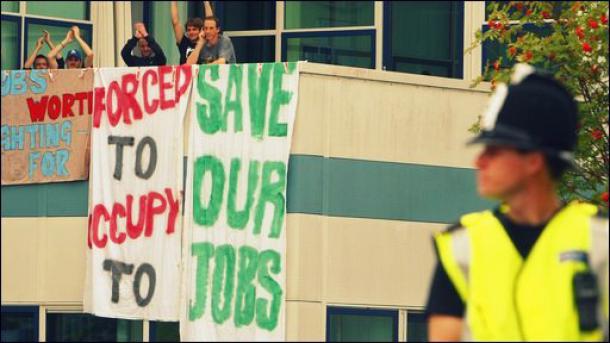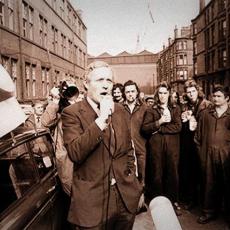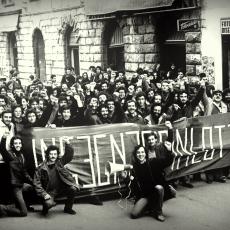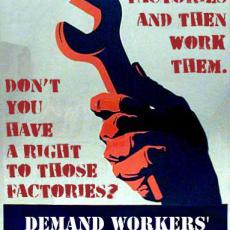Britain: New Wave of Factory Occupations
An account of the Vestas wind turbine factory occupation in July 2009
A rash of workplace occupations is spreading across the globe as workers defy the brutal consequences of the recession. Instead of surrendering to mass redundancies and outright closures, workers are occupying their workplaces as a central method of struggling for justice.
Every example that wins concessions is boosting the belief of other workforces that there is an alternative – militant class action can win at least something.
VICTORY TO VESTAS
The sit-in at Vestas wind turbine factory on the Isle of Wight is creating a storm of international publicity and sympathy for the 600 workers who face the dole, at the same time as the Labour government recently pledged to create 400,000 new green jobs over five years. The 25 Vestas workers who have occupied their factory, supported by nightly mass rallies, have shown tremendous courage in the face of attempts by the bully-boy, anti-union Vestas bosses to evict them.
The bosses tried to starve the workers out, blocking food supplies sent by supporters. They threatened the sack and denial of redundancy payments from the workers involved. They took out an injunction to gain re-possession of the factory – in order to close it and move production overseas. The National Union of Rail, Maritime and Transport Workers (RMT) took up the workers’ legal defence and won at least a delay in the possession order being issued – primarily because of the visible display of widespread solidarity outside the factory gates and on several demonstrations.
The factory was due to close on July 31, but the workers’ seizure won an indefinite extension. Vestas had no union recognition. Some workers joined a union and started organising others. A group established a campaign committee and organised the sit-in from July 20. This bold action won the active support of hundreds of others – Vestas workers, other trade unionists, environmentalists and the local community – on an island where there are no other jobs to go to. Vestas workers have gone further than any of the other recent factory sit-ins by demanding: “Gordon Brown – Nationalise this!”
A statement from the workers declared:
If the government can spend billions bailing out the banks – and even nationalise them – surely they can do the same at Vestas.
VICTORY ENCOURAGES OTHERS
As well as organising solidarity for these heroic fighters for jobs and the environment, we should learn from workers’ experiences of sit-ins as a method of struggle, particularly as redundancies and closures sweep the land like a pandemic.
Vestas is only the latest in a series of workplace occupations in Britain. In Ireland, Thomas Cook workers occupied their workplace on July 31 in defiance of job losses through closure of 100 offices. The recent outbreak of factory takeovers in Britain and Ireland began with Waterford Glass in Ireland, with workers occupying the plant in January over 480 job losses. After eight weeks’ struggle, they reluctantly accepted a deal that saved 176 jobs.
But their example fed the appetite of other workers facing closures under brutal terms. On March 31, more than 600 workers at Visteon (formerly Ford) plants in Belfast, Enfield and Basildon occupied when they were declared redundant at a few minutes’ notice – without any redundancy pay and with their pensions frozen. A month later, the workers won enhanced redundancy terms, payments in lieu of notice and holiday pay.
Prior to that, a small group of non-unionised workers at Prisme in Dundee occupied their workplace, encouraged by Waterford Glass workers. They had been sacked without notice or redundancy pay. Fifty-one days later, the sit-in beat off redundancies by establishing a cooperative.
Workplace occupations are not a new form of struggle, but have a long and proud history. Now, as the global capitalist crisis bites, with even more catastrophic closures and cutbacks on jobs looming, this form of struggle could come back into its own.
POWERFUL WEAPONS OF STRUGGLE
Sit-ins are a powerful weapon: paralysing production; bringing the battle into the bosses’ ‘own territory’; preventing them from stripping the factory of machinery they may want to shift to other production sites; and preventing bosses from bussing in scabs. But a sit-in can still be defeated, or at best win shoddy concessions far short of the potential victories, if workers’ occupations are not combined with campaigning outside the sit-in.
When workers facing closures consider a sit-in, they should try to prepare a campaign seeking solidarity from fellow workers and local communities. Such outgoing campaigning is critical, first to help prevent employers evicting them, second to enhance the prospects of outright victory for their demands.
That was the advice we put into action from day one of the Glacier Metal occupation in 1996. It is clearly what the Vestas workers are doing now. Touring other workplaces; leaflets in the streets with bucket collections and megaphones to explain the case; organising mass pickets, rallies and demonstrations – all this and more was done in conquering outright victory for the Glacier Metal workers’ sit-in.
Another key question is what demands workers should raise when they occupy their workplace. This depends on what they are fighting against. In the case of Glacier Metal, it was dismissal of the entire workforce in the drive to smash the union and rip up hard-won conditions. So full re-instatement of every worker, with continuity of terms and conditions, and continued union recognition, were the demands. And these were won.
In the case of Visteon, workers occupied to win redundancy payments and protection of their pensions. They won substantial concessions, but still lost their jobs.
Vestas workers have made the most far-reaching demands – appropriate to the situation – occupying in support of nationalisation of the factory. With the need to save jobs and the planet, the best route is public ownership of Britain’s only wind turbine factory. This is part of campaigning for public ownership of the energy industry in order to democratically plan green energy production.
Most occupations arise from closures or mass redundancies. So defense of every job is the starting point. Instead of pouring a fortune from the public purse down the throats of profiteering bosses hell-bent on racing the globe in pursuit of super-profits, workers should champion the demand for public ownership of the assets, under democratic working class control, to sustain jobs.
Workplace occupations are not a “one size fits all” method of struggle, applicable on every single occasion. But they are a powerful weapon that should be used far more widely in the teeth of closures and mass redundancies. In the vast majority of cases, they have won huge concessions or outright victories.
On the other hand, in some conditions, strikes in the face of closures can allow bosses to just walk away, leaving whole communities wrecked. Many workers will increasingly see they have nothing to lose and a lot to win by taking up the fight.
Visteon’s Unite convener Kevin Nolan told Labour Research “We just thought: ‘What do we have to lose?’ So we just went for it. If anyone else is in the same position I’d say weigh everything up and if you think there’s a chance of winning something back or improving your situation by occupying the place, then go for it.”
By seizing control of the company assets, including valuable machinery, plus halting production, whilst using the workplace as a huge campaign headquarters, occupations provide workers with an unprecedented platform to take on the bosses who want to heap the crisis they have created on the shoulders of working people.
[Ed. The Vestas occupation ended in mid-August after becoming a major struggle across Britain, and gaining significant international coverage. It gained wide popular support, but opposition from the Labour Party and its Gordon Brown government. The struggle for jobs and control over the plant continues.]






Comments
Post new comment